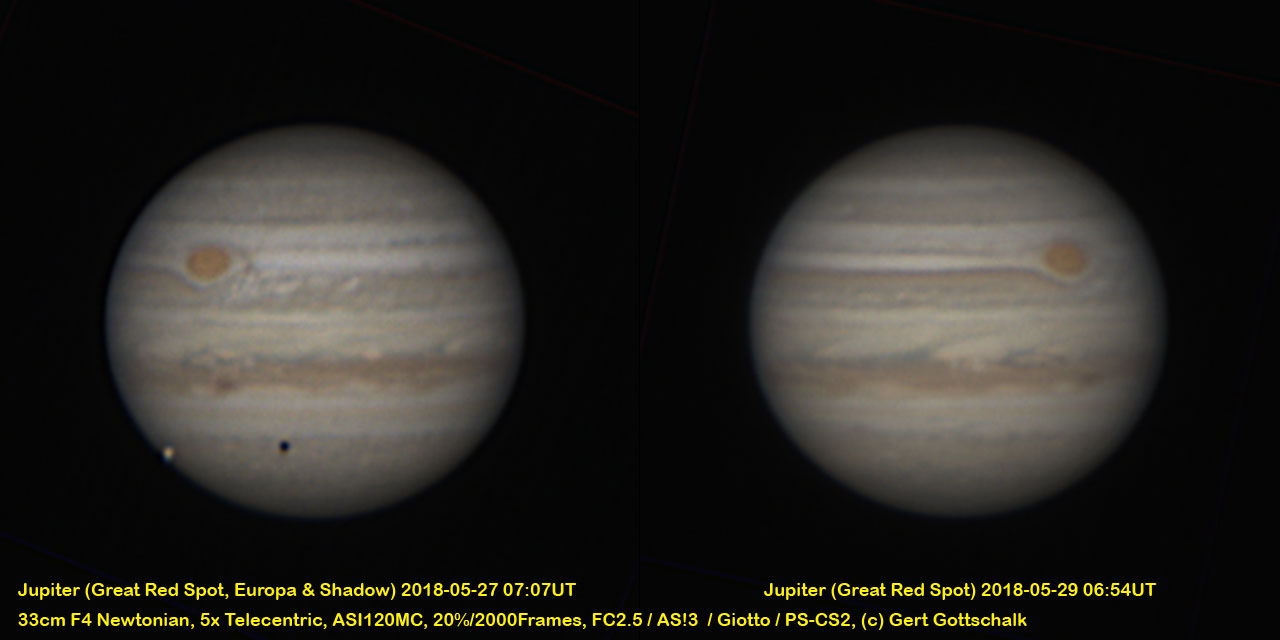Latest observations added at the top.
Images taken with 5inch or 6inch APO refractor or 12inch CDK or 13inch Newtonian
Recording with DMK41 or ZWO120MC with FireCapture. Processing in AstroStakkert!2, Registax 6 and Photoshop CS2.
2018-10-17 02:38UT. This is the first light for the 5x telecentric that is a better match to the pixel of the ASI120 color camera when combined with the F6.5 refractor. The change in magnification no longer allows a direct size comparison of the planet with previous observations, but it is obvious that Mars has gotten considerably smaller. The ephemeris program Stellarium gives an apparent diameter of only 13.58arcsec. Thus not a lot of surface detail can be seen.
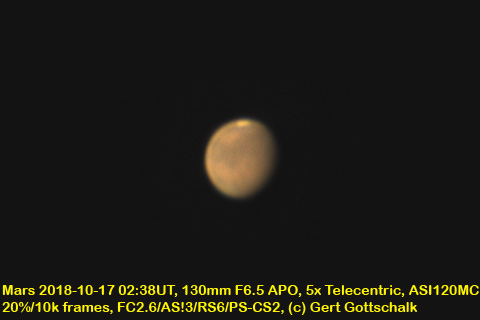
2018-09-09 We had group observing session at the club's site. The wide open horizon view allowed for a sequence of the evening planets Venus, Jupiter, Saturn, Mars. (sequence of observations)

2018-09-04 04:37UT. Moving on to Mars. I had expected better from the seeing but the large aperture and image scale blurred the image quite a bit. There is not much more detail to see with 12inch than with the 6inch.

2018-09-04 03:56UT Jupiter has already moved out of my angle of visibility for the evening and we start the observing session with Saturn in the South. I wanted to try the bigger aperture and image scale of the CDK12 corrected Dall Kirkham Cassegrain. Vs. the 160mm APO the image scale with Barlow lens is about 2x.
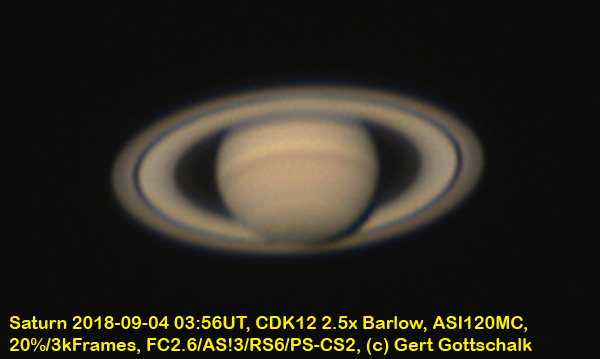
2018-09-02 04:10UT There was a chance to capture Mars with it's moon Deimos at its largest angular distance from mars' glare. The seeing war average and the 4sec exposures blur Deimos and the field stars. To capture the faint Deimos I used the more sensitive ASI174 monochrome camera.

2018-09-02 04:35UT A follow-up of Mars with the ASI120MC color camera.
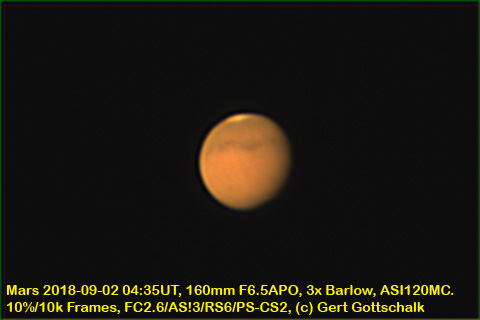
2018-08-19 05:58 - 06:53UT. A series of Mars AVIs put together as animated GIF, next to one of the better frames from the sequence. Mars rotation takes 24hr37min to rotate so during the approx. 1hr of recording we only see a small angle of rotation. Overall the seeing was not as good as on the 12th or the 9th which I think is showing the best level of detail so far.
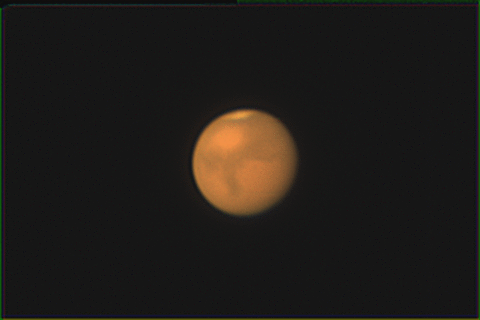
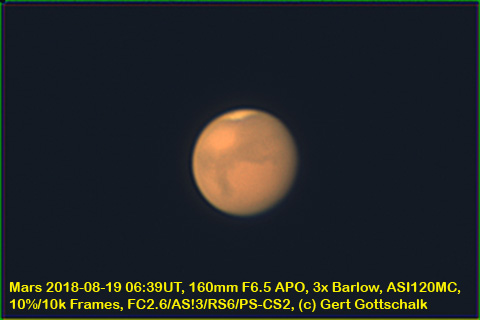
2018-08-12 07:07UT. Mars is still a good sight around local midnight when it has the highest elevation. The seeing was not as good as on the 9th. As the rotation of Mars and earth are almost the same we see the same side of the planet, again.
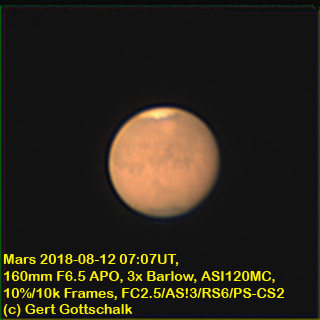
2018-08-12 04:06UT. Jupiter is setting earlier every day and it has moved well away from the meridian in the South and its highest elevation by the time the images were recorded. Today a nice visibility of the Red Spot was the reason to image the giant planet.
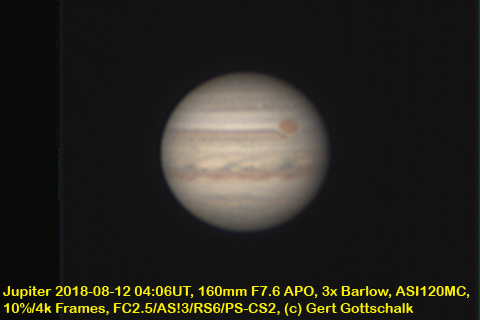
2018-08-09 Between 06:23UT and 07:23UT Mars was high in the South and the seeing was quite OK in spite of the the haze from the wild fire smoke in the atmosphere. Three of the best exposures are shown here. Already some rotation can be seen.
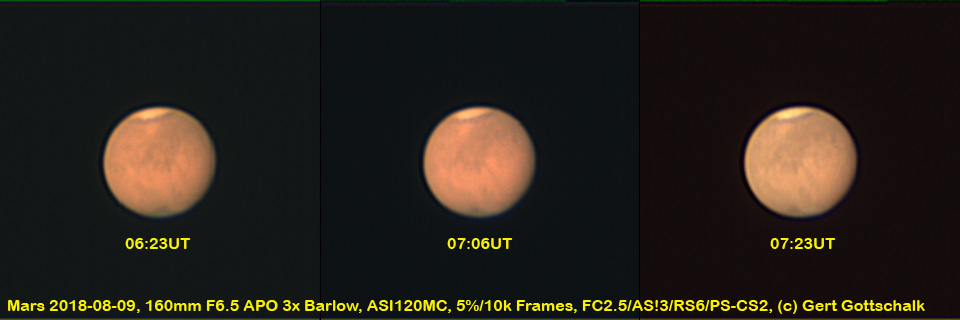
2018-08-06 between changing conditions including smoke from the fireseason I got some images of the three Planets in the evening sky. Again all images were made using the same telescope and camera equipment so that we can compare apparent planetary sizes and detail.
2018-08-06 03:37UT. We begin with Jupiter already in the south-west at sunset. Unfortunately there was no significant feature like the Red Spot or a shadow / transit of one of the moons. In the earlier hours of the evening the seeing was not very good as well.
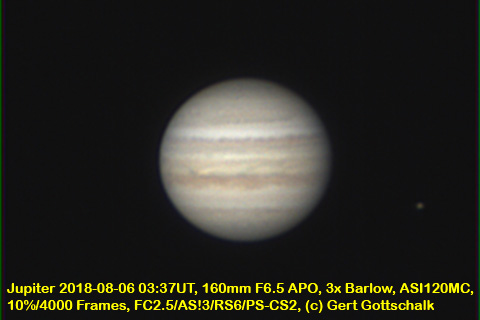
2018-08-06 05:07UT. Next is Saturn which is just South once the observing of Jupiter is done.
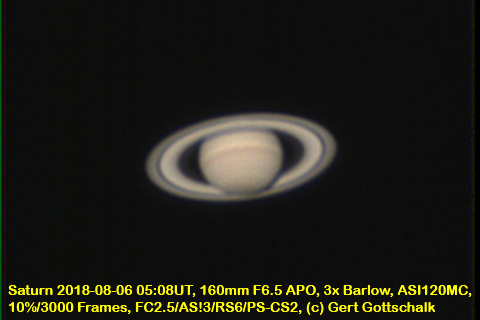
2018-08-06 07:03UT. Finally Mars which has improved from the recent dust storm. We can see some more features on the surface. Also the seeing had improved.
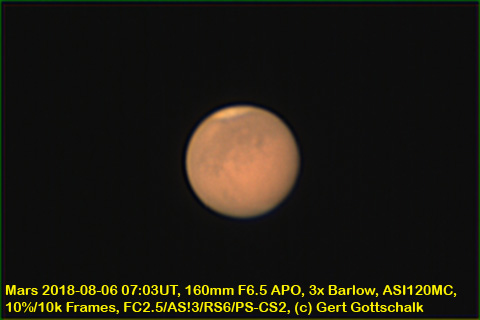
2018-07-31 07:13UT. Another night without good seeing. Mars was jumping around and changing shape constantly. Only 48hrs after the previous image the rotational angle has not changed much. So we are looking at the same hemisphere of Mars, again.
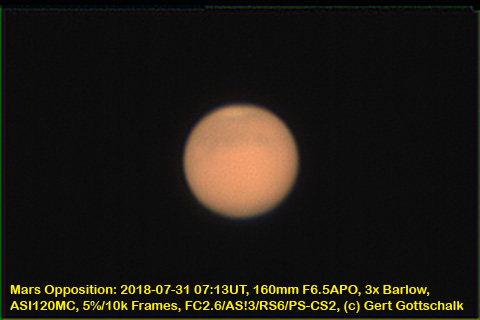
2018-07-29 06:23UT. This is from the date approximately in the middle between Mars opposition on the 27th and closest approach to the Earth on the 31st. Mars is deep south of the celestial equator and seeing conditions were not optimal. In addition we have a dust storm impairing visibility of the surface details.

2018-07-17 This evening the seeing (from my urban area) was quite good and I wanted to check all the three planets in the south after dark. I used the 130mm APO and 3x barlow to have the same iage scale for all images. Quite a nice comparison.
2018-07-17 03:53UT. We begin with Jupiter where we had a nice visibility of the Great Red Spot.
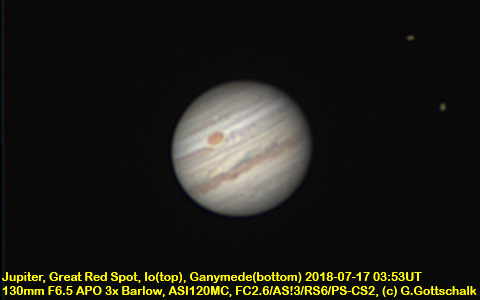
2018-07-17 05:29UT. Saturn. The ring opening angle is still 26.24deg so we see the rings quite well.
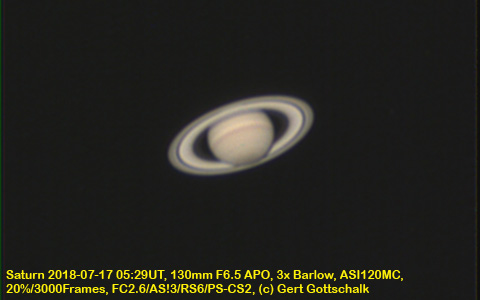
2018-07-17 07:06UT. Finally the planet Mars which is nearing opposition at 2018-07-27 is now 59Mio km away from Earth showing a large disk of 23.5arcsec diameter. Unfortunately there is a dust storm on Mars and the surface features are very hard to see. I put the JPL simulated view next to the image.
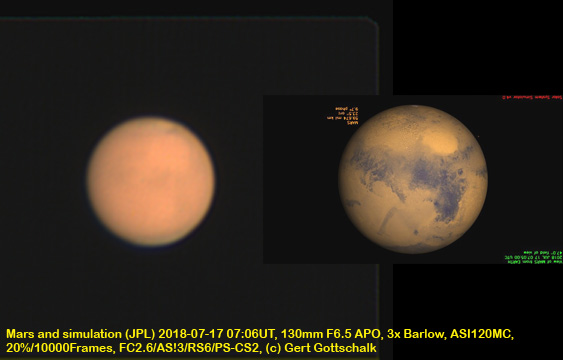
2018-05-27 07:07UT. Following feedback from online forum members I did another processing of the Jupiter data from 5/27. Using AS!3 switch to suppress vertical banding and RGB color align. Followed by Registax6 wavelet sharpening and Photoshop color balancing and level adjustment.

2018-05-27 07:07UT. and 2018-05-29 06:54UT This is the start of the 2018 campaign and additionally first light with an updated 33cm F4 mirror in the 33cm Newtonian. Two nights two days apart had favorable visibilities of the Red Spot. The first night also featured a transit and shadow of the moon Europa. Also for the first time a 5x telecentric (TeleVue Powermate 5x) was used with the ASI120MC camera. Seeing on both nights was good, with the first night still a little bit better.
